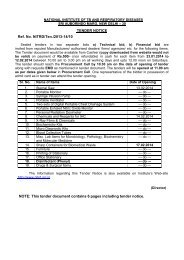October - LRS Institute of Tuberculosis & Respiratory Diseases
October - LRS Institute of Tuberculosis & Respiratory Diseases
October - LRS Institute of Tuberculosis & Respiratory Diseases
You also want an ePaper? Increase the reach of your titles
YUMPU automatically turns print PDFs into web optimized ePapers that Google loves.
TUBERCULOSIS OF SPINE 217<br />
it has established that an initial period <strong>of</strong> rest<br />
in bed <strong>of</strong>fers little if any benefit”.<br />
The Second Report (Medical Research<br />
Council 1973b) on the study at Pusan, Korea<br />
deals with a series <strong>of</strong> 150 children on ambulatory<br />
treatment with the standard chemotherapy<br />
with or without Plaster <strong>of</strong> Paris jacket immobilisation.<br />
At the end <strong>of</strong> three years, 85 per cent<br />
<strong>of</strong> children in plaster jacket for nine months<br />
and 82 per cent <strong>of</strong> children without jacket had<br />
responded favourably. The corresponding figures<br />
for the increase in the gibbus at three years<br />
were 12° and 10° respectively. 80 per cent <strong>of</strong><br />
patients on triple regimen and 87 per cent <strong>of</strong><br />
patients on isoniazid and PAS had a favourable<br />
response. Therefore the triple regimen was no<br />
more effective than the two-drug regimen.<br />
P.O.P. Jacket <strong>of</strong>fers no benefit.<br />
The Third Report (Medical Research<br />
Council 1974a) concerns a study in Bulawayo.<br />
Rhodesia where a controlled trial <strong>of</strong> debridement<br />
and ambulatory treatment with a. second<br />
random allocation <strong>of</strong> triple or two-drug regimen<br />
for eighteen months was done. Unlike the<br />
Korean studies the series included a high<br />
proportion <strong>of</strong> adult patients. Debridement<br />
consisted <strong>of</strong> the removal <strong>of</strong> pus, caseous<br />
material, sloughs and sequestra but not deliberate<br />
removal <strong>of</strong> unaffected or viable bone.<br />
85 per cent <strong>of</strong> the debridement series and 86<br />
per cent <strong>of</strong> ambulatory series had favourable<br />
results at third year. There was significant<br />
mean vertebra] loss in debridement series while<br />
the increase in gibbus was not significant. Bony<br />
fusion had occured in 51 per cent <strong>of</strong> debridement<br />
series and 67 per cent <strong>of</strong> ambulatory series<br />
at three years As in Korean series, there was<br />
little difference between SPH and PH series’, 84<br />
per cent and 86 per cent respectively responding<br />
favourable at three years.<br />
Debridement is not a good operation.<br />
83 per cent <strong>of</strong> biopsy specimens were histologically<br />
and/or bacterologically positive for tuberculosis.<br />
In Bulawayo a clinical diagnosis <strong>of</strong><br />
active tuberculosis was nearly always proved<br />
correct.<br />
The Fourth Report (Medical Research<br />
Council 1974b) compares the anterior spinal<br />
fusion (Rad. series) and debridement on patients<br />
(Deb. series) on triple drug regimen for<br />
18 months at Hong Kong. The mean total<br />
vertebral loss on admission was 0.7 in each <strong>of</strong><br />
the series; at three years a mean gain <strong>of</strong> 0.2<br />
<strong>of</strong> a vertebra in Rad. series and a mean further<br />
loss <strong>of</strong> 0.2 <strong>of</strong> a vertebra in Deb. series was seen<br />
(P< 0.001). There was a significant increase<br />
in the gibbus angle <strong>of</strong> 0.9° for the Rad. series<br />
and 4.5° for Deb. series at three years (P=0.1).<br />
Radiographic evidence <strong>of</strong> bony fusion <strong>of</strong> affected<br />
vertebral bodies was 93 per cent and 69<br />
per cent respectively at 36 months (P—0.003).<br />
The favourable response was 87 per cent and<br />
86 per cent respectively at three years.<br />
Eighty five per cent <strong>of</strong> 149 specimens were<br />
histologically tuberculous and/or yielded positive<br />
cultures for tubercle bacilli. The radical operation<br />
is, therefore, a better procedure.<br />
In all there were 630 patients in four studies.<br />
The favourable status <strong>of</strong> various series were<br />
nearly identical at third and fifth years excepting<br />
in radical surgery where 89 per cent showed<br />
favourable status by 18 months.<br />
Griffith (1979) states that “on the evidence<br />
<strong>of</strong> this (first) series <strong>of</strong> trials (Medical Research<br />
Council (1973a, 1973b, 1974a, 1974b, 1976,<br />
1978), spinal tuberculosis uncomplicated by<br />
paraplegia should be treated by adequate<br />
chemotherapy combined with Hong Kong<br />
radical operation, if, only if, surgical expertise,<br />
adequate anaesthetic facilities and skilled nursing<br />
are readily available. If these facilities and<br />
skills arc not available, the operation should<br />
not be performed, and reliance should be<br />
placed with confidence on ambulant out-patient<br />
chemotherapy. In-patient care and plaster<br />
jackets were not shown to confer any advantage<br />
and advantages that might be claimed for<br />
operative debridement do not appear adequate<br />
to justify that operation as a therapeutic<br />
measure, valuable as it may be as a means <strong>of</strong><br />
diagnosis in an otherwise difficult diagnosis<br />
problem”.<br />
The Rationale <strong>of</strong> Short Course Chemotherapy<br />
for <strong>Tuberculosis</strong> <strong>of</strong> Spine<br />
The merits <strong>of</strong> short course chemotherapy<br />
are that the medication can be supervised and<br />
the case holding is easier. Several reports have<br />
appeared in recent years on short course chemotherapy<br />
in the management <strong>of</strong> pulmonary<br />
tuberculosis. “<strong>Tuberculosis</strong> <strong>of</strong> parenchymatous<br />
organs is characterized by a high bacterial<br />
population; tuberculosis <strong>of</strong> bone by a low one<br />
(Canetti, Debeyre and De Seze 1957). Debauinout<br />
(1966) showed that the total bacillary<br />
population <strong>of</strong> tuberculous spine may amount<br />
to fewer than are million organisms. A positive<br />
sputum on the other hand, may contain upto<br />
300,000 bacteria in 1 millilitre (Boquet 1938).<br />
This low bacterial population also implies the<br />
likelihood <strong>of</strong> a lower incidence <strong>of</strong> drug resistant<br />
mutants in spinal disease than in pulmonary<br />
tuberculosis (Canetti and Grosset 1961) and it<br />
may be that this makes the spinal involvement<br />
Ind, J. Tub., Vol. XXIX, No. 4

















